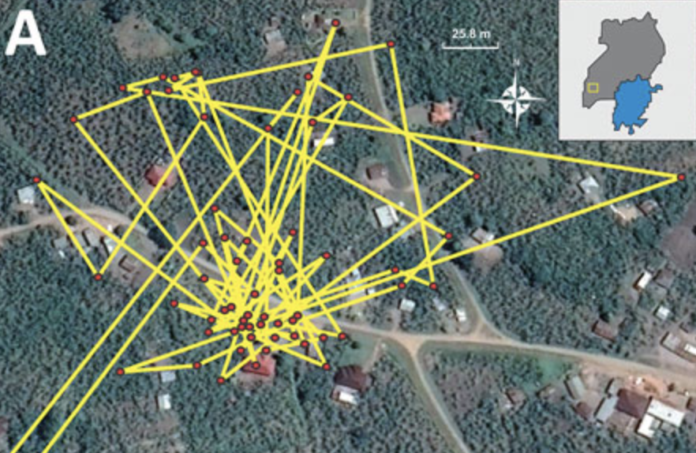Marburg virus (MARV) and Ravn virus (RAVV) (family Filoviridae, genus and species Orthomarburgvirus marburgense) are the causative agents of Marburg virus disease (MVD). The prototypical filovirus and close relative of Ebola virus, MARV was identified in Germany and the former Yugoslavia in 1967 when laboratory workers had MVD develop after handling infected African green monkeys (Cercopithecidae: Chlorocebus tantalus) imported from Uganda. Since then, 16 additional MVD outbreaks have been reported, with case-fatality rates of 23%‒90%. A reported large MVD outbreak in Africa (>100 cases) occurred at the Gorumbwa mine in eastern Democratic Republic of the Congo during 1998‒2000, followed nearly a decade later by 2 small outbreaks, at the Kitaka mine in southwest Uganda in 2007 and Python Cave in Queen Elizabeth National Park, ≈32 km from Kitaka mine, in 2008.
Subsequent ecologic investigations identified the Egyptian rousette bat (ERB; Rousettus aegyptiacus), a cave-dwelling fruit bat, as the MARV natural reservoir based on the repeated detection or isolation of MARV and RAVV directly from ERBs captured at those and other locations. This conclusion is further supported by experimental infection studies showing that ERBs are capable of shedding MARV for up to 3 weeks, the highest amounts in oral secretions and urine and to a lesser extent in feces, and that sustained bat-to-bat MARV transmission is possible under laboratory conditions in the absence of any other animals or arthropods normally found in their natural habitat.
Many MVD outbreaks were associated with direct human encroachment into ERB roosts and presumably exposure to infectious ERB material such as urine or feces. However, more than half (9/17) of historic MARV spillover events are epidemiologically unlinked to ERB cave habitats or infected secondary hosts. Because ERBs in Africa prefer to roost in unpopulated forested areas, pinpointing the intersections between ERBs and humans is difficult. Moreover, human infection with MARV occurs through broken skin or mucous membranes such as the eyes, nose, or mouth, implying the need for direct or indirect contact with an infected bat or infectious bodily fluids.
The question remains then, how do MVD outbreaks that are geographically distant from and epidemiologically unlinked to caves or mines get started? One possibility is suggested by virus stability studies showing that MARV remains viable for up to 5 days on surfaces such as wool and glass or up to 6 hours on the surfaces of banana and mango, favorite foods among wild ERBs. This level of virus stability might provide sufficient time for humans, nonhuman primates (NHPs), or other potentially susceptible wildlife or domestic animals to be infected by indirect contact with contaminated surfaces or by consumption of fruits soiled with infectious ERB urine, feces, or saliva. ERBs routinely test bite and discard unwanted fruit or spit out masticated fruit pulp in the tree or on the ground, providing another means for releasing infectious virus into the environment. This behavior of test biting fruit most likely extends to all ERBs throughout their distribution in sub-Saharan Africa, where multiple other MVD outbreaks have occurred . We used micro‒global positioning systems (micro-GPS) to track nightly movements of ERBs in Uganda to identify opportunities for MARV spillover to humans.




